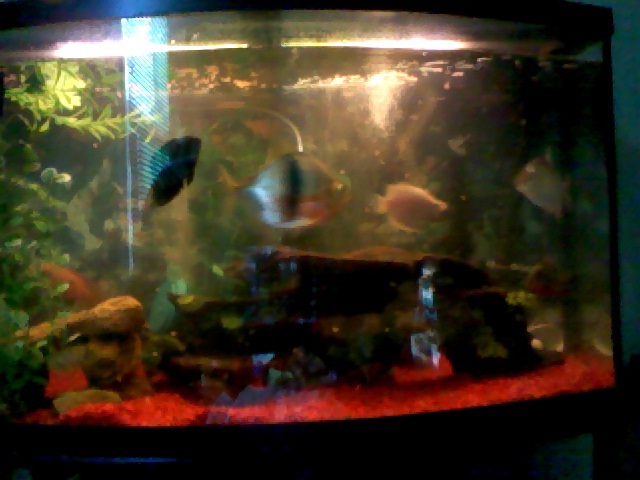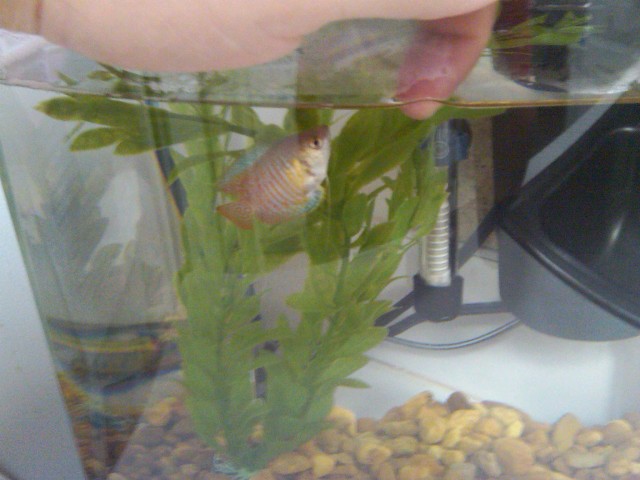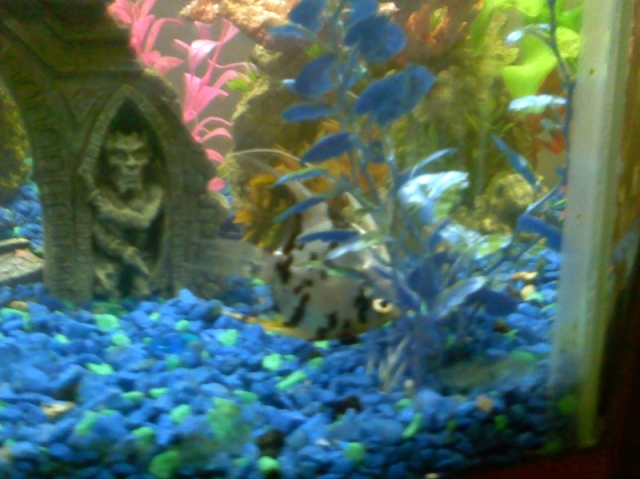QuestionI just check the levels in my tank because two days ago i found that i have 5 new babies in my tank. I have a 55 gallon tank. Which have 5 fish in it. I had more before but i am new at having fish and 5 of them died and i have not purchased any more yet. My nitrate level is between 20 and 40, and my nitrite level is between 2.0 and 5.0. My PH level is about 7.2 but my tank has always had a higher ph level and the fish seem to be okay now they got use to it. what can i do to get the levels down, i do not want to use chemicals because of the babies, but i don't want my other fish to die either.
thank you,
Jamie
AnswerHi Jamie,
The best thing you can do right now is water changes. Your nitrites will go down eventually - your tank just isn't really cycled yet, and the issue now is diluting the nitrites by adding fresh, clean water.
Don't worry about the pH. Almost all fish will adapt to most any pH, as long as it is stable and doesn't fluctuate too much. Well, actually there is an exception - fish that need hard water, such as livebearers and goldfish, will not do well in soft water. A pH of over 7 is not a bad thing. Even if the pH is as high as 8, that's all right. Water with a high pH usually has a high alkalinity level also, and this will keep your water very stable and steady - it's alkalinity that keeps pH buffered. This website explains aquarium chemistry in simple terms:
http://www.drhelm.com/aquarium/chemistry.html
Anyhow, all I mean to say is that you shouldn't worry about your pH or try to change it. Just add dechlorinator to make your tap water fish safe. I like to use Prime, in the 50 mL bottle, because that sized bottle has a dropper cap - 2 drops per gallon is all you need, and the dropper cap makes dosing super simple! Look for Prime, by Seachem, although another dechlorinator I like to use is Tetra AquaSafe. Make sure it dechlorinates both chlorine and chloramine, this is important.
If you can, change 25% of the water daily. Another filter would really help also, preferably one that comes with biological media. Filters with bio-wheels are a fine choice. My favorite filters are the AquaClear filters, I use two foam sponges and a bag of Biomax:
http://www.drsfostersmith.com/product/prod_display.cfm?pcatid=3610
Other than [expensive] products containing live bacteria (such as Tetra Safe Start or One and Only) there is not going to be any kind of chemical that will help with removing the nitrites right now, except biological media, which will be a host to the beneficial bacteria you are trying to cultivate...since it's beneficial bacteria that turn ammonia into nitrites, and nitrites into nitrates.
Ammonia and nitrites ought to be 0 ppm in a healthy, established tank, but nitrates can be as high as 20 ppm. So, that means your goal is to change enough water so that nitrites register 0 ppm. I urge you to change as much water as you can daily - this will help a lot!
You don't mention what kind of babies these are, but if they are livebearer babies (mollies, platys, swordtails, guppies...etc) then they will all be very tolerant of salt, and salt helps with nitrite toxicity. Use 1 tablespoon per 5 gallons, so about 5 tablespoons for your whole tank. Dissolve it in warm water first, and use non-iodized salt. This means basically anything but table salt...kosher salt, pickling salt, sea salt, aquarium salt...they are all the same.
This is what I would do, along with feeding the babies frequently. One thing that I've found that babies readily pick at and that DOESN'T pollute the water at all (well, it leaves messy strands, but it doesn't cloud the water) is nori. This is sheets of roasted seaweed, used for making sushi. You can find it in the ethnic or Asian section of most grocery stores. Since it's light, a couple of plastic clothespins will weigh it down, and the babies can pick at it.
Any kind of vegetables will also be picked at by the babies, but I especially suggest: cucumber, melon, squash, zucchini, and any kind of dark green lettuce. Use a magnetic refrigerator clip (like a Chip Clip) to weigh down the slices of veggies, the babies will pick at them when they become soft. You can also microwave them for a bit.
Cooked peas (canned without salt, or frozen and defrosted) work really well also, since they sink right to the bottom all by themselves. Just pinch the skins off...I bet all your fish will eat some peas!
Give the babies (and your fish) lots of vegetables, since veggies don't pollute the tank the way ordinary flakes do. Low protein, high fiber foods like veggies may make a bit of a mess, but it's high protein foods like flakes that make water go cloudy.
Frozen baby brine shrimp or daphnia is a fine food for the babies, the trick is getting them to find it. Frozen brine shrimp or bloodworms works well too. Again, the frozen foods are not as polluting as the highly concentrated flake - it would be best if you could stay away from feeding much flake right now. If you have to feed flake or pellets, just feed once a day. However, I highly recommend you have a vegetable in there all the time for the babies to pick at.
I hope those suggestions help, take care!
Nicole
P.S. Since you mention being new to fishkeeping, try these sites:
http://www.firsttankguide.net
http://freshaquarium.about.com

 is my tank over stocked
Question
my tank
is my tank over stocked ...
1 jewel ci
is my tank over stocked
Question
my tank
is my tank over stocked ...
1 jewel ci
 betta tank
Question
my betta tank
hi jaymie, i have a betta tank w
betta tank
Question
my betta tank
hi jaymie, i have a betta tank w
 high PH levels
Question
Our 90 Gallon Tank
We recently set up at 90 ga
high PH levels
Question
Our 90 Gallon Tank
We recently set up at 90 ga
 another question, and thanks for your help
QuestionQUESTION: Hi, Renee. I wanted to thank yo
another question, and thanks for your help
QuestionQUESTION: Hi, Renee. I wanted to thank yo
 Angelfish acting abnormal and not eating
QuestionQUESTION: I have two angelfish.
For many month
Angelfish acting abnormal and not eating
QuestionQUESTION: I have two angelfish.
For many month